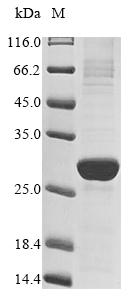Thanks for your inquiry.
Recombinant Human Peptidoglycan recognition protein 1(PGLYRP1)
CSB-EP017862HU >> E.coli
Expression Region: 22-196aa; Full length of the mature protein.
Tag information:N-terminal 10xHis-tagged and C-terminal Myc-tagged.
Sequence:
QETEDPACCSPIVPRNEWKALASECAQHLSLPLRYVVVSHTAGSSCNTPASCQQQARNVQHYHMKTLGWCDVGYNFLIGEDGLVYEGRGWNFTGAHSGHLWNPMSIGISFMGNYMDRVPTPQAIRAAQGLLACGVAQGALRSNYVLKGHRDVQRTLSPGNQLYHLIQNWPHYRSP
(1).If it's a re-order from the Lot# 03942, please remark this information when you place the order.
We can meet your demand to decrease the glycerol content, in theory, the content ranges from 5% to 50% is OK.
Please remark your requirement for the glycerol when you place the order.
(2).Sorry, we can't sell the expression vector.






